Tillandsia bradeana Mez & Tondas. Now T. brachycaulos
Click thumbnails for full size, scaled to a new window.
Tillandsia bradeana Mez & Tondas. Now T. brachycaulos
Formerly T. bradeana abdida
-Treated as synonyn of T. brachycaulos schlchtd. See Smith & Downs 1977, 1000
-Treated as a species on it's own, T. bradeana. See Gardner 1982, 195
-Treated as synonyn of T. brachycaulos schlchtd. See Luther & Sieff 1997, 113
-Treated as a synonym of T. brachycaulos in S&D but considered by Luther in Binomials 8, 2002 to include T. abdita even though there are several discrepancies in the descriptions – see below.
*See T. brachycaulos page for examples of similar plants.*
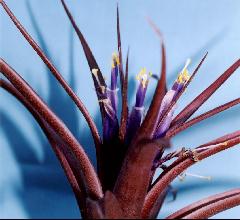
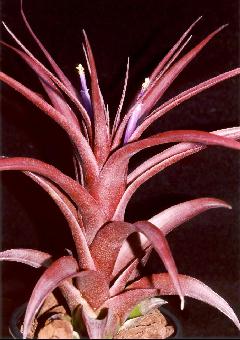
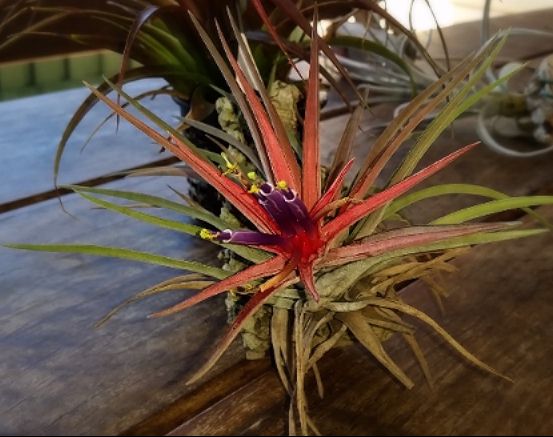
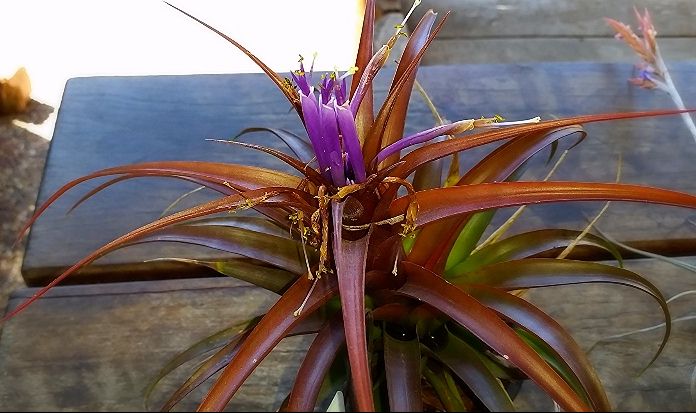
| Ken Woods 11/04. |
Mark Supple 12/14. |
Mark Supple ... "Labelled as brachycaulos, but is T. abdita. I must get around to changing the label."
Derek Butcher ... "T. brachycaulos was described in 1844. In 1962 T. abdita was described.
In 2002 Harry Luther considered, and published, that T. abdita was unnecessarily named and should be left as T. bradeana as described in 1916."
From Taxon List, 2017
-T. bradeana treated as synonyn of T. brachycaulos schlchtd. See Smith & Downs 1977, 1000
-Treated as a species on it's own, T. bradeana. See Gardner 1982, 195
-Treated as synonyn of T. brachycaulos schlchtd. See Luther & Sieff 1997, 113
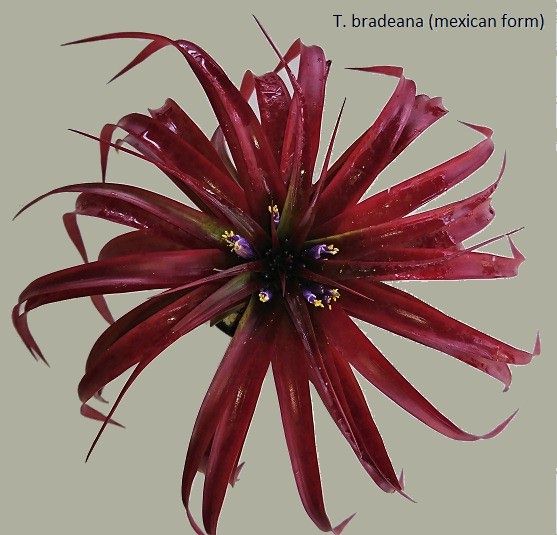
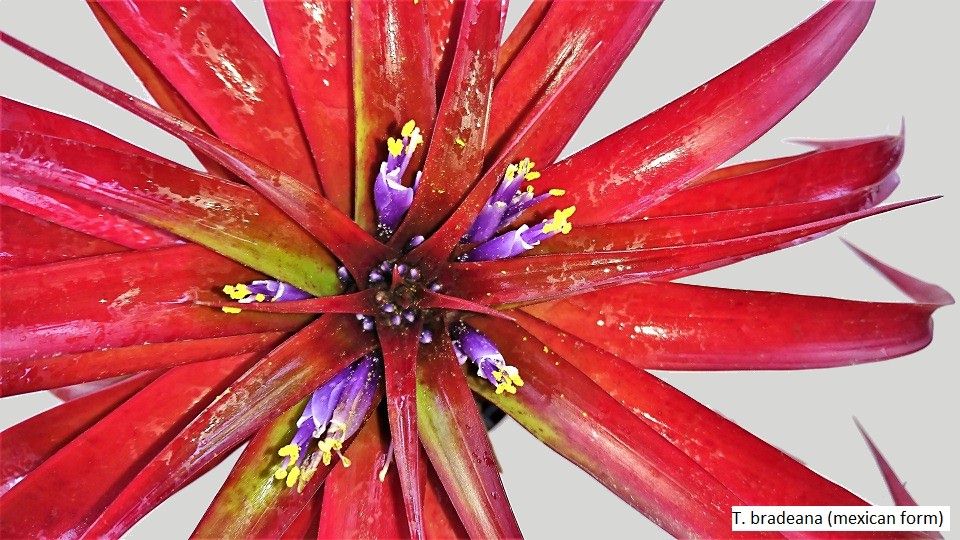
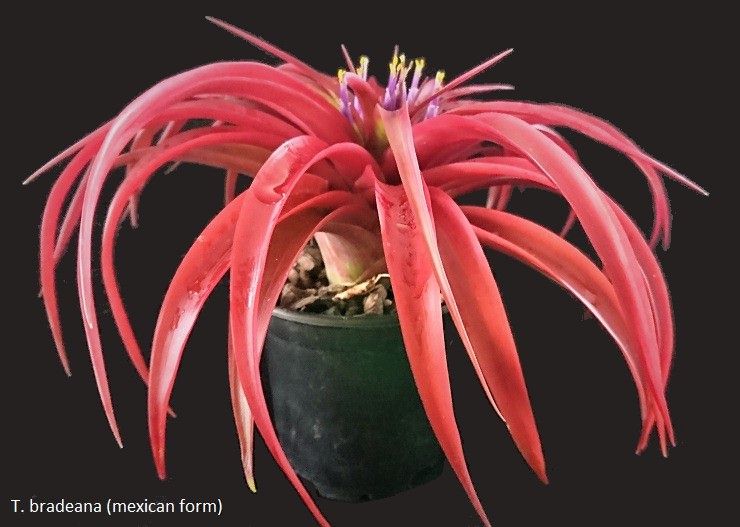
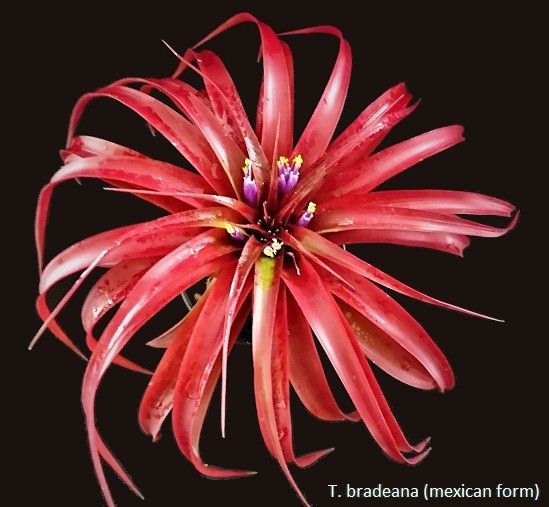
| Steve Molnar 06/17 as T. bradeana (Mexican form) |
Steve Molnar ... "This is a stunning looking plant and I have been enjoying watching it change leaf colour over the last couple of weeks. It seems to be loaded with flowers and I hope to get plenty of seed and pups from it to keep this species going strong. It lives in the same place as all the other tills under 50% shade cloth, I must have just found its happy spot so that is where it will continue to live."
Chris Larson ... "I am of the understanding that T. bradeana (syn T. abdita) is endemic to Costa Rica. For a while Collectors Corner was selling this as T. bradeana along with many others – so I have contributed to this as well. On advice from Derek & Peter, we have now changed our label for this plant to T. brachycaulos.
I find this whole complex of T. capitata & brachycaulos very confusing where the plants become close."
John Olsen ... "I have been labelling this one bradeana short form. I have clones from several sources. I'll change to brachycaulos.
I also have a plant which when I got it still had the tropiflora label and marked Costa Rica. It has a taller scape and doesn't get so solidly red as Steve's plant."
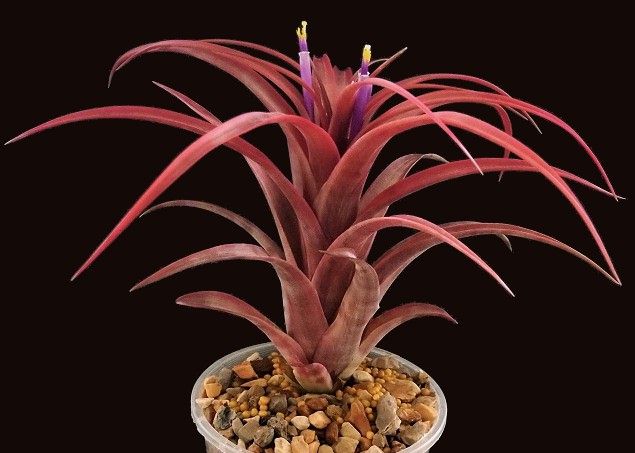
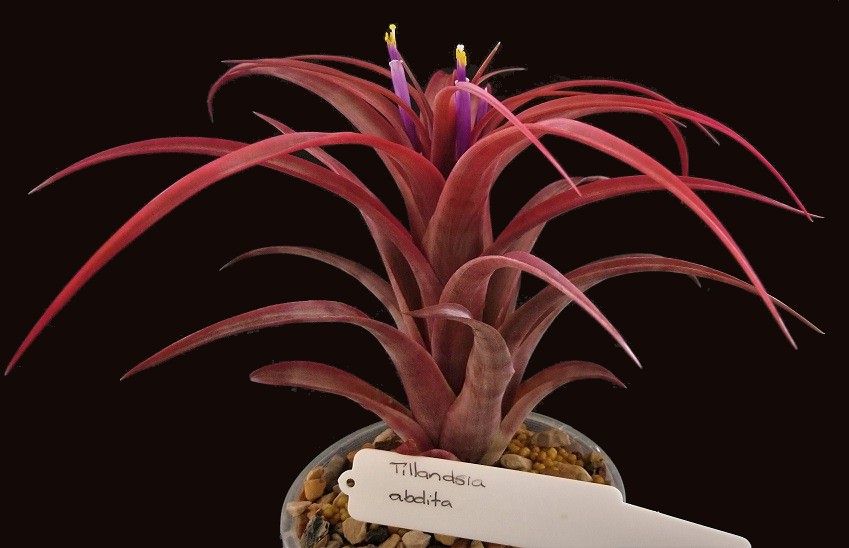
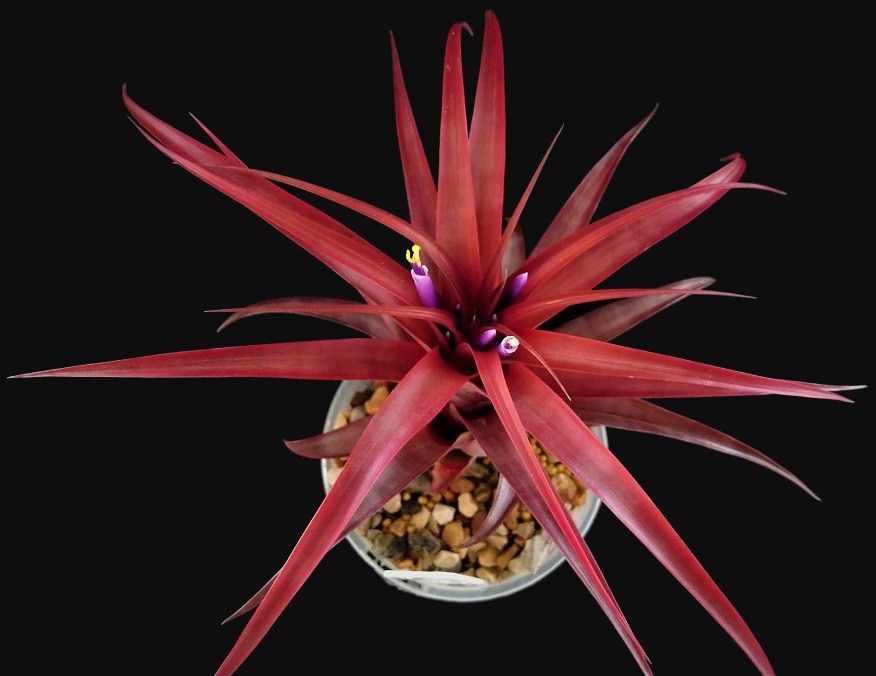
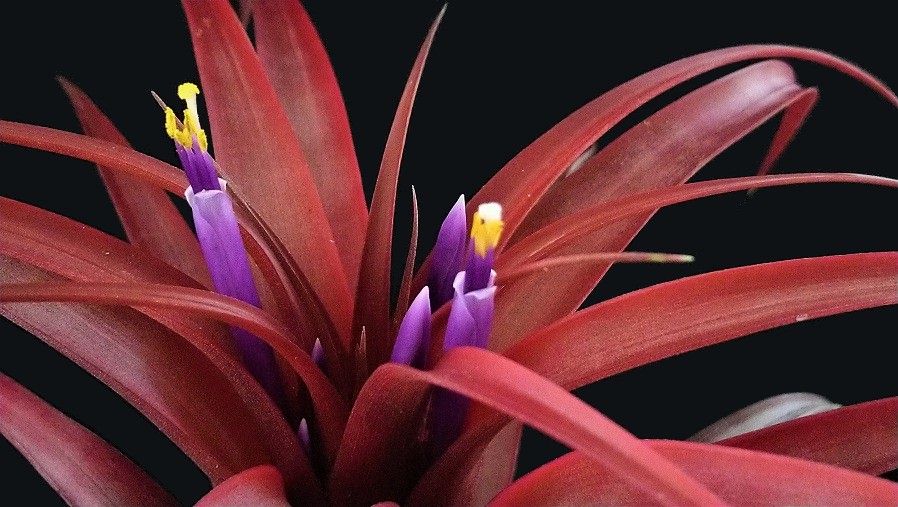
| Steve Molnar 03/19 as T. abdita |
Enquiry from Diane Colnale about a plant labelled abdita ‘Mex’.
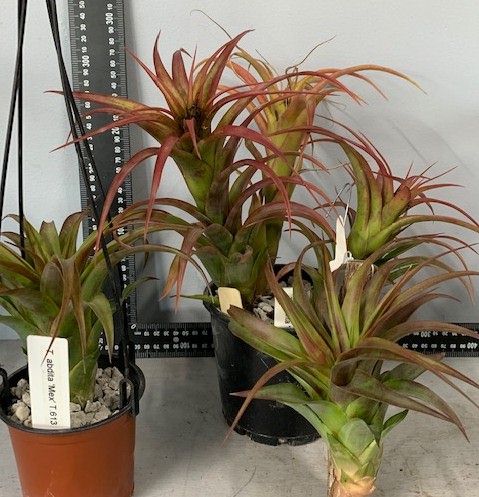
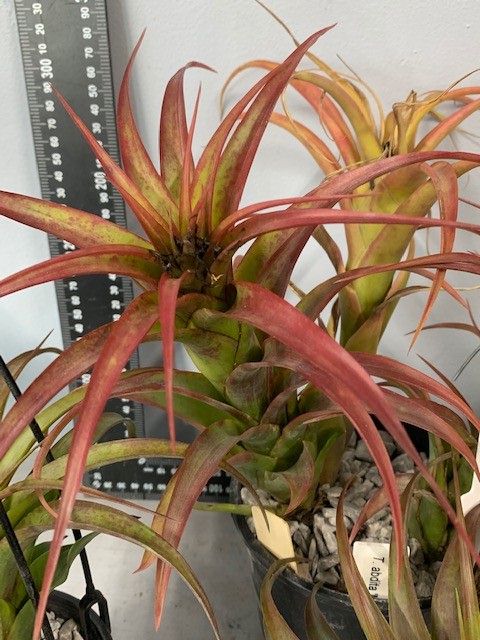
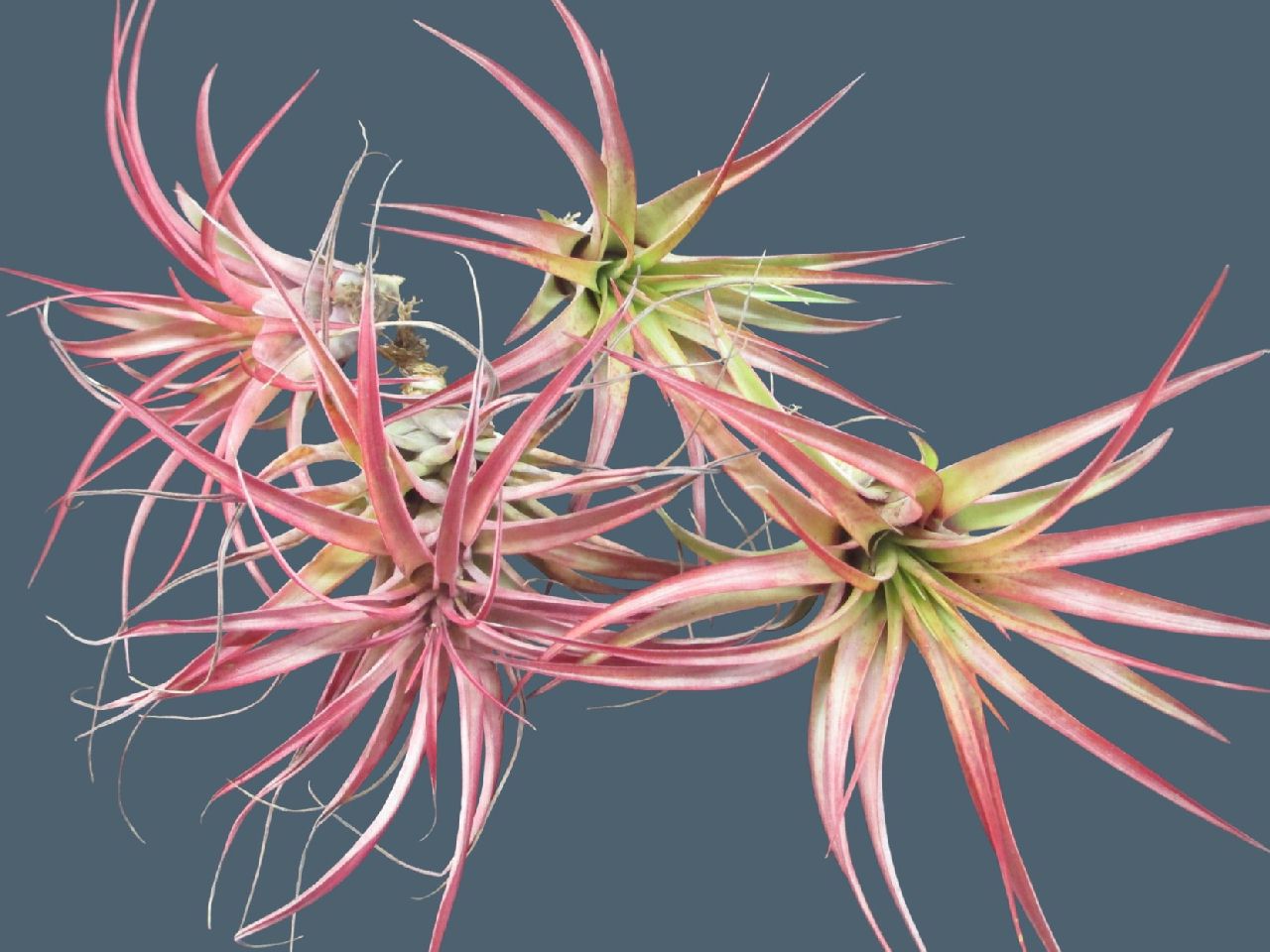
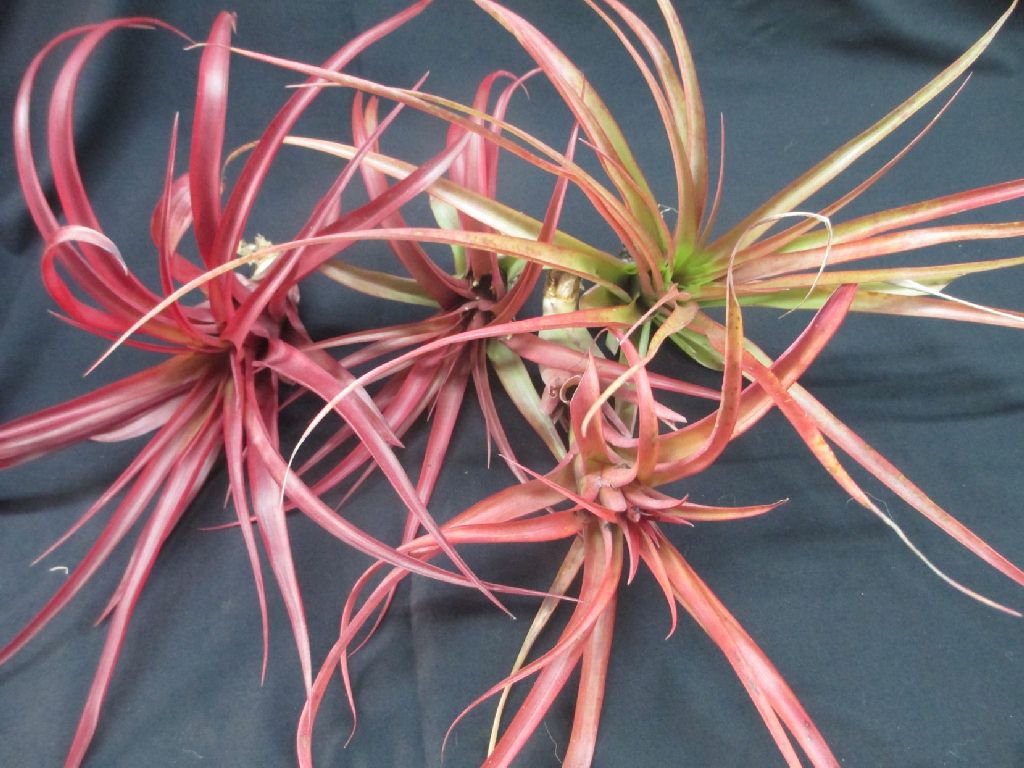
Diane Cornale 08/19 as "abdita Mex"
| Bob Hudson 08/19
|
|
Diane Cornale ... "This plant was bought at the 2012 TPE Auction. Label reads abdita ‘Mex’. So we suspect Mex is Mexico, but the abdita is not listed on FCBS or BinA site, but we have found it listed as a species in Google search. Any ideas please?"
Geoff Lawn ... "According to the authoritative New Bromeliad Taxon List (Gouda / Butcher) , T. abdita is an old synonym of the currently-recognised T. brachycaulos."
Peter Tristram ... "It’s a shame the taxonomists lumped the old abdita group, though...
I saw the old species at its type location in Costa Rica in 1990. The habitat was well over 1000 m higher than where common old brachycaulos grows in the lowlands, cooler and wetter in remnant trees in coffee plantations. The old abdita is harder to grow too and blooms and pups infrequently. As for the Mexican abdita, I was told that it also is a highland plant. It comes in a few forms too! It’s like the capitata dilemma, I suppose - not enough differences to separate them all."
Derek Butcher ... "This is linked to T. bradeana and is reported from CostaRica where it grows on the same mountain as T. brachycaulos. If you are really keen and are prepared to take your plants to bits you could check against the documents below.
It would seem that this clone is widespread in Australia but no one seems to know who gave it this name or history. Perhaps a registered cultivar name is a way to formally record its history."
Peter Tristram ... "Interesting Derek. I don’t remember this info in our many previous discussions. If brachycaulos grows anywhere near ex-bradeana/abdita, I sure didn’t notice, though there’s plenty along the coast, at the foot of the hill so to speak, in a very different life zone."
Chris Larson ... "A few of us call it in common terms “the old Mexican Abdita” or something similar. My tags say T. brachycaulos “Abdita Mex” & I have been guilty of passing it on like that."
Peter Tristram ... "Chris: This goes round in circles! I guess Derek is right! Not entirely about bradeana in Costa Rica, but about naming the other brachies. How about the dark red one with shiny leaves too, ex Mexico as far as I can gather? Bright green until it blooms, then, wow! I got a nice looker from Alan P at the pop up sale too. I wonder if Alan knows its provenance. It’s labelled T. abdita ex someone but I’m not going out searching labels now! Was it a certain Bob? It looks a big grower too. I also got a nice one from another Butcher but it was ex Paradisia I think. Most are variations on a theme but some forms are very distinctive . It might be a good idea to track provenance of the differing forms if we’re to justify cultivar names? Maybe other collectors can post their brachycaulos pics with any info they have."
Chris Larson ... "I’m happy with the descriptors. I’ll leave the "Mex Abdita" on my purple form. I just can’t work out when descriptors are considered fine and when things are supposed to be registered."
Chris Larson ... "I’ve also seen this as the T. brachycaulos ‘Mexican Bradeana’ come to think of it. It is basically a form of T. brachycaulos (though, as Peter says, it has some variation) from Mexico that some collectors need a name on to keep it different from all of the rest. T. brachycaulos Abdita Mexico or something like that works."
John Olsen ... "It does help to have some means of differentiating plants. I’m not a fan of taking a form of ionantha for example and calling it Smith for example. Then the link back to ionantha is hidden.
Now to abdita which became bradeana. I have a tall form from Tropiflora out of CostaRica. If anything it may have more similarity of form with some capitata but softer leaves. I have a compact form ie low inflorescence in the leaves which colours very dark red which traces back to Hobbs 2004. For all appearances they differ from the various plants I’ve bought as brachycaulos.
I’m sticking with bradeana with a bracketed brachycaulos reference. Likely we’ll have new species split out if we wait a while."
Bob Hudson ... "Here are some of my T. abdita/bradeana/ brachycaulos/capitata (see above). The first Photo(left) is the small forms and the second(right) is the larger forms. Some more colored than others. I have imported some others acquired from growers in OZZ."
Chris Larson ... "I think it has been solved. It should be T. brachycaulos "Abdita Mex". No probs. A range of plants emanating from the same region. As Peter says there is no hope of getting exact provenance. So long as we dont drop the T. brachycaulos it's all hunky-dory."
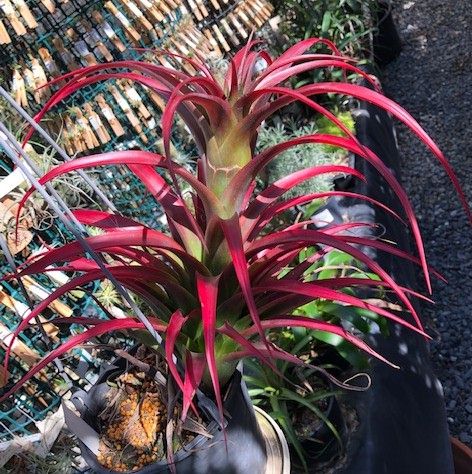
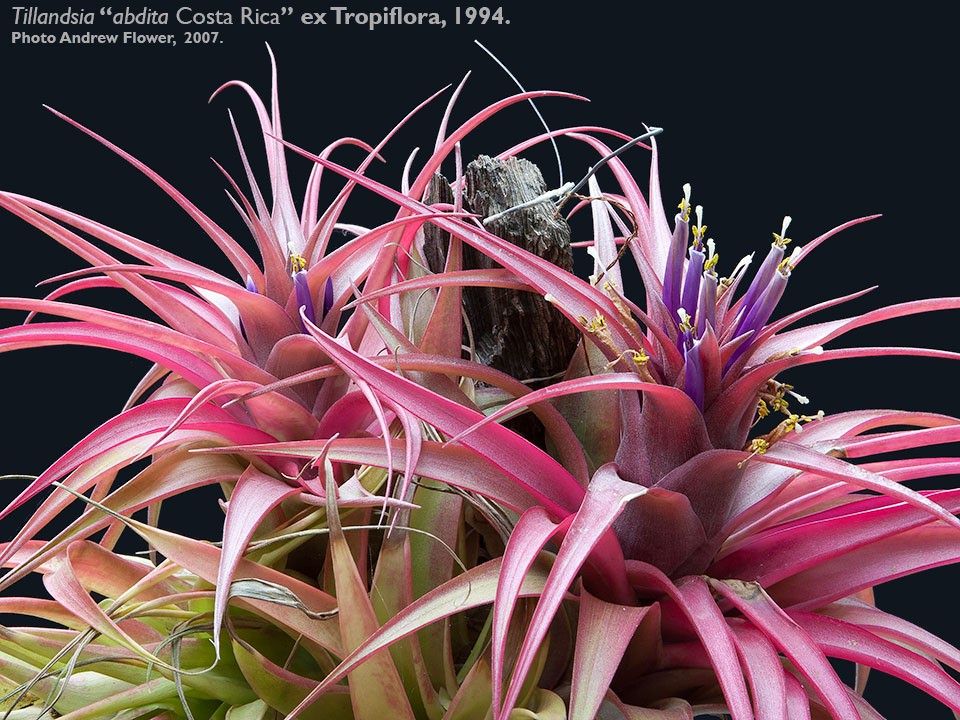
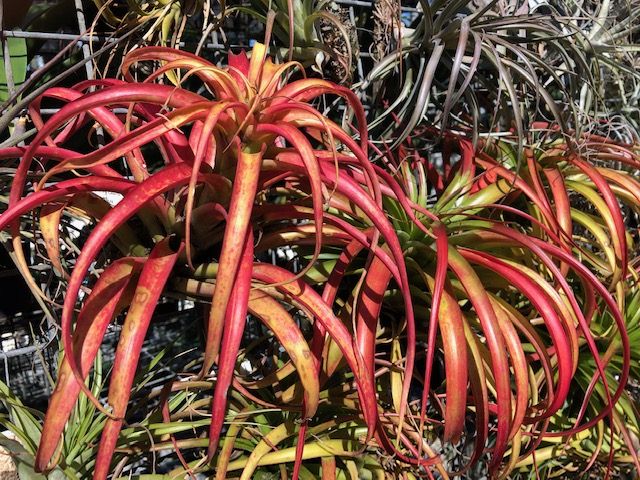
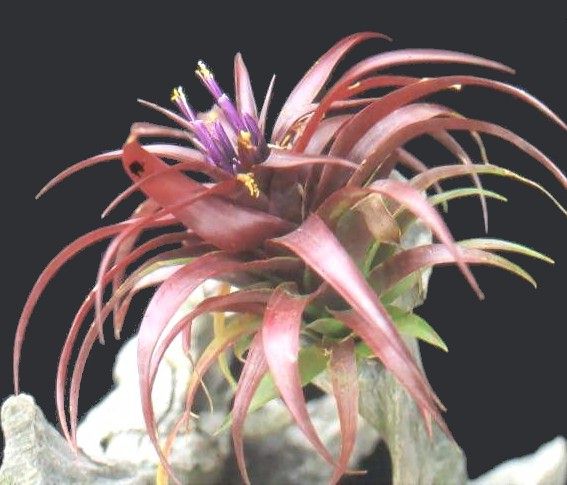
John Olsen 08/19 #1164 as bradeana 'Costa Rica'"
Andrew Flower 08/19 as abdita 'Costa Rica'"
John Olsen 08/19 #1164 as brachycaulos 'Mex' ex.Bob Hudson"
| Chris Larson 08/19 #1164 as abdita 'Mex 1' ex.Cathcart"
|
| | |
Andrew Flower ... "I got a "Tillandsia abdita Costa Rica" from Tropiflora in 1994, attached pic of it flowering in 2007. Also got a "Tillandsia abdita Mexico" in the same shipment."
Derek Butcher ... "Andrew: Yes there is confusion in the ranks of taxonomists as to what is a T. brachycaulos. At the moment it includes abdita and bradeana as synonyms. From what I can gather, taxonomists have always agreed that these 2 species are linked to Costa Rica. There are plants circulating in Qld called abdita 'Mex' which suggests it was found in Mexico which is somewhere the taxonomists have not mentioned. It could only have been coined by the nursery trade and better covered by a cultivar name. If I had ever grown such a plant I would have tried to find its history and written about it but alas I have never grown this plant and can only suggest to others that it is an exception and should be written about as a cultivar.
You are growing this abdita Mex which must be different to abdita Costa Rica and I suggest that you may like to write a short article explaining the difference."
Derek Butcher ... "I got a "Tillandsia abdita Costa Rica" from Tropiflora in 1994, attached pic of it flowering in 2007. Also got a "Tillandsia abdita Mexico" in the same shipment."
Andrew Flower ... "John Olsen: Yes, many are satisfied with the name on the label but some like Diane and myself like to ask why. We try to mainly follow the taxonomist and wild collected plants and what they write about them to the minutest detail. In this case it seems to have been given this name by some unknown nurseryman and both Diane and myself are curious."
Chris Larson ... "As Peter says, this particular form ex-Mexico is known to some collectors. It is a T. brachycaulos – but someone need to differentiate it for us. Hence the name which denotes what we know of the history. As Peter says – the exact provenance of each form may not ever be known. You could write it up, but there are so many plants like this."
Derek Butcher ... "What happens to these variants when a taxonomist is not involved? To me just writing details on a plant label is insufficient and if there are several of such plants being grown a registered cultivar name is in order. I do this if I have been growing such plants but try to encourage others to do so if they have an inquisitive mind. Hence my encouragement to Diane."
Chris Larson ... "Yep. There is no science to apply. Peter & my point. Someone may do research in the wild & publish in the future and my tag will point in the direction if they do. But I think it is satisfactory to give it a cv name as per your suggestion.
The history for someone that wants to name it:
1. Been around for yonks. Collectors Corners import came in pre 1992
2. Was traded under the name T. abdita. Then changed to T. bradeana with the demise of T. abdita. I don’t know the year the taxonomists wiped it out. I have always had doubts about the name T. abdita as Renate told me not at the 1995(?) Conference in Adelaide when I tried to get her to explain the capitata / brachycaulos complex.
3. Before 2000 we already knew that this was a Mexican form of T. brachycaulos and therefore not T. bradeana. Peter had taken it apart and we knew it was T. brachycaulos. But I was of the opinion that this was still traded in the USA under the name T. abdita.
(Confusion abounds – before and after T. velutina was described in 1994, T. velutina was traded all over the world by the majority of the exporters – via the Guatemalans – as T. brachycaulos var abdida or T. brachycaulos ‘Abdida’. Those importing into the USA, largely, followed suit – except BRT.)
Asides:
I think that Derek does many of the US importer/exporters a disservice. They largely used Selby Gardens as a source for names. I believe some of the names came from Harry Luther, but were taken out of context, where Harry probably said “looks like” & that went on the label without checks. Similar to what many do in Australia currently. “The expert says …” rather than “the expert guessed at the time …” when he was put on the spot to judge a photo between drinks at a conference.
Peter has a big talk/show weekend in Sydney, and so hasn’t weighed back in – I was interested in his comment about the Costa Rican populations of a typical T. brachycaulos plants coming from a different altitude to the ones that were called T. bradeana – with a distinct gap in between ranges. If I’ve got things right. Much of taxonomy did not (in the past) take into account geomorphology as a serious arbiter when T. bradeana was synonymised with T. brachycaulos. So, as a result, the synonomy may later be called into question. (Those thinking the changes to taxonomy are solely based on DNA should be aware that traditional taxonomy still plays a very big part , but is informed by DNA and geomorphology – calling them “the DNA changes” is inaccurate.)
Peter also mentioned, I think implied, that these so called T. abdita from Mexico may come from a distinct location and possibly at a greater altitude. The photo (attached) from the disc is the one I think of when I think of T. brachycaulos “Mexican Abdita’. Interesting that at one stage it appears that Renate was calling the Mexican plant bradeana – and it is still on the disc as this????
Any article & registration would have to have some detail in it with regards to the habitat. Does Peter, Pam Koides or Derek know?"
Tillandsia bradeana Mez and Tonduz Fedde, Repert. XIV. (1916) 252. – Treated as a synonym of T. brachycaulos in S&D but considered by Luther in Binomials 8, 2002 to include T. abdita even though there are several discrepancies in the descriptions – see below.
60. T. Bradeana Mez et Tonduz in Fedde, Repert. XIV. (1916) 252. – from Mez Bromeliaceae (1934)
Florifera ad 0,2 m alta, praecedentibus satis validior. Folia utriculatim rosulata, per anthesin extimis paucis exceptis fulgide rubra, decurvata, ad 0,2 m longa et super vaginam 20 mm lata, inde in apicem sensim angustata, minutissime lepidota specie glabra. Scapus brevissimus quidem sed tamen flores ultra foliorum rosulam efferens, densissime foliis omnino iis rosulae aequalibus indutus celatusque. Inflorescentia submultiflora, cyathidiiformis, corymbosa, densissima; bracteis primariis omnino foliaceis flammide rubris, spicas omnino celantibus; spicis ad 25 mm longis, 1-3-floris, evidenter distichis subflabellatis, sessilibus; bracteis florigeris glabris laevibusque, submembranaceis vel subcoriaceis, ovato-ellipticis, vix carinatis, late acutis, quam sepala brevioribus. Flores stricte erecti, e bracteis primariis emergentes, ad 70 mm longi; sepalis posticis inter sese altius quam cum antico connatis, ellipticis, acutis, submembranaceis, glabris, minute venosis, ad 17 mm longis. Petala strictissime tubulose erecta, saturate violacea, quam stamina optime breviora.
Costarica : bei San Jose (Werckle n. 37 in Herb. inst. phys.-geogr. Costaric. n. 16414). - Durch Tonduz eingefuhrt; bluht bei mir jedes Jahr. - Fig. 96.
0bs. Species n. 58-60 arctissime inter sese conjunctas pro speciei ejusdem formis minore, media et majors sumeres.
Plant flowering to 20 cm. high, strong growing.
Leaves forming an inflated rosette, a few outside leaves turn a shiny red at anthesis, decurved, to 20 cm. long, 20 mm. wide above the sheath, then narrowing to a tip, glabrous to the very small lepidote.
Scape very short, however producing flowers above the leaf rosette, hidden by the very dense leaf rosette.
Inflorescence almost many flowered, cup shaped like a corymb. very dense.
Primary bracts all leaf like, flaming red, concealing all the spikes.
Spikes to 25mm. long, 1 – 3 flowered, clearly distichous, fan shaped, sessile.
Flower bracts smooth, glabrous, almost membraneous or almost leathery, ovate elliptic, barely keeled, broad acute, shorter than the sepals.
Flower strictly erect, emerging from the primary bracts, to 70mm. long.
Sepals posterior pair joined higher than the front one, elliptic, acute, sub- membraneous, glabrous, minutely veined, to 17mm. long.
Petals strict, erect tube, deep violet, much longer than the stamens.
Habitat Costa Rica near San Jose
Tillandsia abdita L. B. Smith, Phytologia 8: 10 ,Pl. l , fig. 15-17. 1961.
Desc from S&D p1001 for protologue see jpg
Plant stemless.
Leaves numerous, suberect, 16 cm long, covered with appressed cinereous scales, reddish;
Sheaths merging with the blades;
Blades narrowly triangular , attenuate, ca 2 cm wide, slightly recurving.
Scape very short, wholly concealed by the leaves.
Inflorescence depauperate-compound, few-flowered, capitate, much exceeded by the leaves;
Primary bracts foliaceous but reduced, much exceeding the spikes;
Spikes densely 2-flowered, complanate.
Floral bracts oblong, acute, 17 mm long, exceeding the sepals, carinate, membranaceous, subdensely lepidote with pale brown appressed scales;
Flowers subsessile.
Sepals free, exactly like the floral bracts;
Petals and stamens unknown.
Type. Solis 314 (holotype F), Cerro de Escasu, San Jose, Costa Rica, Aug 1935.
DISTRIBUTION. Known from the type collection only.
Description by J Francisco Morales in INBio Instituto Nacional de Biodiversidad 24 Sept 1999
Plant epiphytic
Leaves 9.5 – 19.5 (27.5) cm long, chartaceous to sub-coriaceous.
Sheath 2.3 – 3.3cm wide, cinnamon, adpressed lepidote, passing gradually to the blade.
Blade 1.4 – 2.2cm wide, triangular, densely lepidote, usually mulberry to reddish-mulberry.
Scape 5.5 – 10cm long, erect, hidden by the leaves.
Scape bracts leaflike, much longer than the inflorescence.
Inflorescence erect, 4 – 5cm long, capitate to sub-capitate, terminal, bracts much larger than the side branches which are less than 2cm, with 1 – 2 flowers.
Floral bracts 1.7 – 2.2cm, much longer than or equal to the sepals, ecarinate, nerved, glabrous, membranaceous to sub-chartaceous.
Sepals 1.7 – 2cm long, lepidote, membranaceous.
Petals lilac.
Capsules 2.9 – 3.6cm
Distribution Endemic. Cerros de Escazu, Cordillera de Talamanca (El Rosario, Llano Los Angeles), Cerros de Caraigres, Elevation between 1600 – 2000m
NOTES: From Derek Butcher.
Francisco Morales of Costa Rica has been doing some research (Sept 1999) into this species - Refer INBio Web site. He refers to Smith’s original description but does not point out the differences that he must have found and should have commented on. He has not responded to my queries! These are:-
| . | Smith | Morales |
| Scape | Very short | 5.5 to 10cm long |
| Floral bracts | exceed sepals
carinate
lepidote | shorter or equalling
not carinate
glabrous |
| Sepals | free | not noted |
If we follow this new information the matter becomes even more complex when we only rely on whether the bracts or sepals have trichomes. To my mind T. abdita differs from T. brachycaulos by having a pronounced scape and T. abdita differs from T. capitata by the purplish leaves (but then T. capitata can have these too!) In all it is very puzzling that a very variable T. capitata is accepted as, too, is a narrowly defined T. abdita (but proved variable - see above) both in description and geographical distribution.
Updated 01/09/19



















